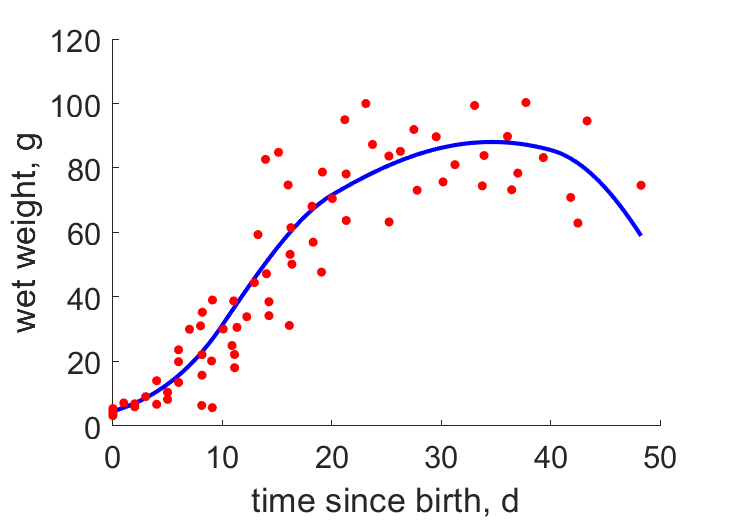Predictions & Data for this entry
| Model: std | climate: BSh, BWh | migrate: | phylum: |
| COMPLETE = 2.5 | ecozone: TA | food: biHn, biHs | class: |
| MRE = 0.058 | habitat: 0iTf | gender: Dg | order: |
| SMSE = 0.011 | embryo: Tnwf | reprod: O | family: |
Zero-variate data
| Data | Observed | Predicted | (RE) | Unit | Description | Reference |
|---|---|---|---|---|---|---|
| ab | 20.5 | 21.24 | (0.03606) | d | age at birth | avibase |
| tx | 31.5 | 31.2 | (0.009675) | d | time since birth at fledging | avibase |
| tp | 94.5 | 90.36 | (0.04376) | d | time since birth at puberty | guess |
| tR | 456 | 456 | ( 0) | d | time since birth at 1st brood | AnAge |
| am | 1.278e+04 | 1.278e+04 | (0.0005828) | d | life span | AnAge |
| Ww0 | 5.68 | 6.039 | (0.06325) | g | initial wet weight | avibase |
| Wwb | 5 | 4.499 | (0.1002) | g | wet weight at birth | avibase |
| Wwi | 86.5 | 90.24 | (0.04329) | g | ultimate wet weight for females | avibase |
| Wwim | 87.4 | 86.34 | (0.01212) | g | ultimate wet weight for males | avibase |
| Ri | 0.0117 | 0.01156 | (0.01174) | #/d | maximum reprod rate | avibase |
Uni- and bivariate data
| Data | Figure | Independent variable | Dependent variable | (RE) | Reference |
|---|---|---|---|---|---|
| tW |  | time since birth | wet weight | (0.1882) | Pear1998 |
Pseudo-data at Tref = 20°C
| Data | Generalised animal | Nymphicus hollandicus | Unit | Description |
|---|---|---|---|---|
| v | 0.02 | 0.02737 | cm/d | energy conductance |
| p_M | 18 | 463.1 | J/d.cm^3 | vol-spec som maint |
| k_J | 0.002 | 0.01913 | 1/d | maturity maint rate coefficient |
| k | 0.3 | 0.3022 | - | maintenance ratio |
| kap | 0.8 | 0.9456 | - | allocation fraction to soma |
| kap_G | 0.8 | 0.8007 | - | growth efficiency |
| kap_R | 0.95 | 0.95 | - | reproduction efficiency |
Discussion
- Body temperatures are guessed
- scaled functional response turned out to vary
- Males are assumed to differ from females by {p_Am} only
- mod_1: Pseudo-data point k is used, rather than k_J; Data set tp and parameter t_R are added, the latter replacing clutch interval t_N. Postnatal T is based on PrinPres1991, see get_T_Aves. See further the revision page, theme puberty
Bibliography